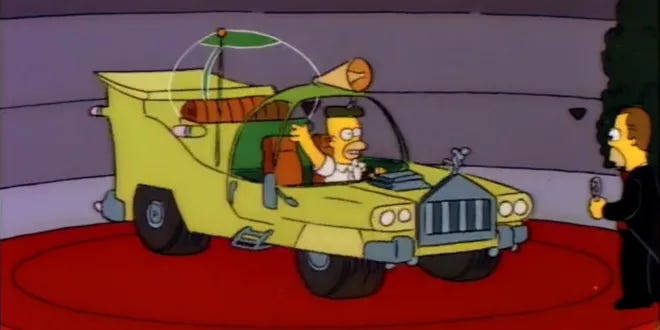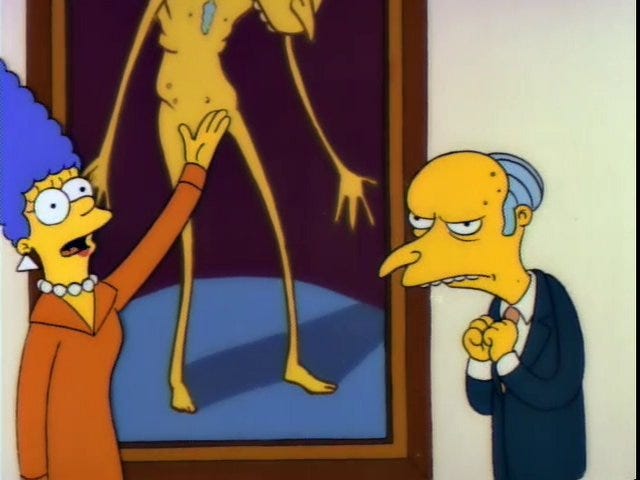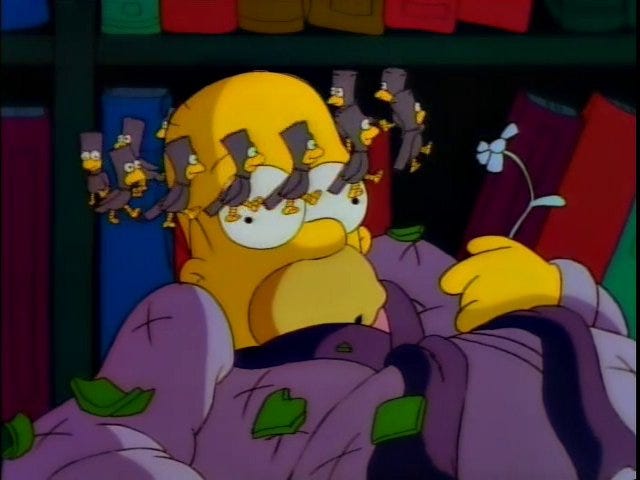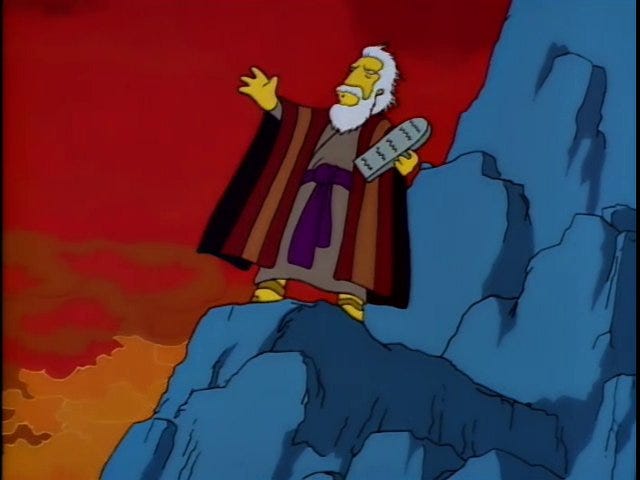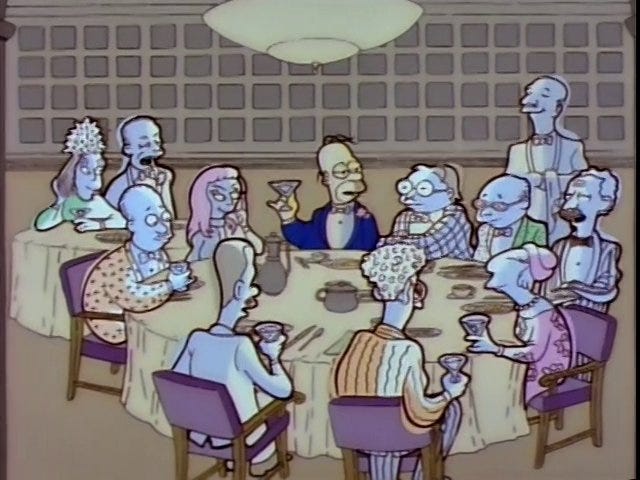There are 22 episodes in Season Two of The Simpsons. In this post, you’ll first find the CLASSIC Scale episode score for each, listed from best to worst. Then, the season’s category averages and results. Finally, some commentary on the season’s strongest and most improved categories.
I explain my method here. This is the master document, containing my up-to-date all-time rankings list.
Great
Treehouse of Horror
O Brother, Where Art Thou
Bart the Daredevil
Very Good
Homer vs. Lisa and the 8th Amendment
Lisa’s Substitute
Bart’s Dog Gets an ‘F’
Blood Feud
Good
Principal Charming
3 Men and a Comic Book
Itchy and Scratchy and Marge
Dancin’ Homer
War of the Simpsons
The Way We Was
Pretty Good
Brush With Greatness
Bart Gets an ‘F’
Two Cars in Every Garage and Three Eyes on Every Fish
Dead Putting Society
Almost Good
One Fish, Two Fish, Blowfish, Blue Fish
Old Money
Simpson and Delilah
Bart Gets Hit by a Car
Bart Ruins Thanksgiving
Season Two Rankings
Category Average Score
(S1 → S2)
Characters: 6.67 → 7.57 (+0.90)
Laughs: 6.27 → 7.25 (+0.98)
Artistry: 6.94 → 7.59 (+0.65)
Story: 6.92 → 7.38 (+0.46)
Setting: 6.79 → 7.40 (+ 0.61)
Irreverence: 6.94 → 7.17 (+0.23)
Classic-ness: 7.37 → 7.43 (+0.06)
Average Episode Score: B
Statistically, the second season is one of massive improvements. This is felt especially in relation to the first season’s Weakest and Most Varied categories. The former, Laughs, confidently finds its goodness— in my opinion, the stats match with experience here. It’s a funny season, featuring a bunch of episodes where the Homer we love is finally established. From the first couple episodes, they take a much funnier approach to the character. Whether Homer’s obsession about stolen cable TV, his multiple crashes down Springfield gorge, or the absolute decimation of his long lost brother’s immense fortune, Homer constantly exceeds the boundaries of his own failure. As far as I’m concerned, the post office scene, where he fails to trick the teller into believing he’s Mr. Burns, is one of the funniest moments in the show’s history. (“I Don’t Know…”).
But it’s not just Homer; all sorts of familiar characters suddenly become funny in Season Two, and other new characters are popping laughs from their introductions. Dr. Hibbert, Troy McClure, Groundskeeper Willie, Lionel Hutz, the Flanders’s’s beyond Ned, Sideshow Mel, are just a few who make memorable debuts. Others who were around but unspectacular before- like Ralph Wiggum, Martin Prince, and Lenny and Karl- are suddenly distinctive and funny. Nelson does his first “ha ha!”. Guys like Skinner, Wiggum, Moe, Burns all remain rough around the edges but take meaningful steps toward their primes. Marge gets a couple good episodes, Lisa gets some very good ones. Even celebrity one-offs like Danny DeVito’s Herb and Dustin Hoffman’s Mr. Bergstrom are unforgettable and hilarious. All this growth clearly speaks to the strong improvement in the Characters category, which leaps from less than good up to approaching greatness.
But neither of these categories rank as high as Artistry, which is exceptional throughout Season Two.
The Season’s Strongest: Artistry
7.6 / B (“Good”)
It may seem a little surprising that the Artistry ranks so high this early in the series. While improved from Season One, the animation still doesn’t hit the series’ sweet spot. To be fair, no category has yet. Ambitious, imaginative, well-executed animation ideas stand out from the start of the season, beginning from the season premiere. The “Snow Day” sequence in Bart Gets an ‘F’ is ambitious. Bart prays for an extra day to prepare for his big exam. God grants him a massive surprise snowfall. As he’s getting ready to play outside, Lisa reminds him his prayer was literally answered. Sucking this up, Bart convinces himself he’s not really missing out on much: “How good could it be?”
Well, the procession of images that follows is a foray into pure whimsy. The townspeople are all sledding, snowball fighting, ice sculpturing and skating. A marching band underscores Mayor Quimby’s declaration of “Snow Day: The Funnest Day in the History of Springfield!” Plus, Arthur B. Rubenstein’s medley of over-the-top holiday-infused orchestral themes and melodies is brilliant. It’s one of his two music credits in the show, and both in the second season.
I also think this is the first fantastical scene is the first of its kind in the series— a completely surreal cutaway that is a real event rather than a look into a character’s mental life, such as a dream sequence.
Through the second season they find more opportunities to make escapes from the everydayness of Springfield life, finding excuses to start stretch its creative boundaries. Obviously, an example is the season’s best episode, Treehouse of Horror.
Moments like the family’s entrance to Capital City in Dancin’ Homer (ft. an original tribute to the town crooned by Tony Bennett)… Or Homer’s dream about his ancestor witnessing Moses in Homer vs. Lisa and the 8th Commandment.
Or that same episode, when Lisa’s guilty conscience has her seeing the Simpson living room transform into a literal hellscape (one of Satan’s two appearances in the season— the other is in Bart’s imagination).
When Marge asks Homer to recollect his shameful drunken buffoonery at her party, his twisted memory of the evening is my favourite moment of the season.
The baseline animation of the show will of course improve in the proceeding seasons, but the bold swipes of surrealism offered by Season Two are a monumental advancement from so much of the show’s first season.
Overall
The 7.4 / B / “Good,” rating seems just about right. Greatness is not out of sight. In fact, 3 episodes are great and another 7 are approaching. Only 5/22 episodes fall out of the B range, with nothing dropping into the Ds. Significantly better ratio than Season One.
In watching, all that progress is felt and I like Season Two a lot more than I thought I did.




